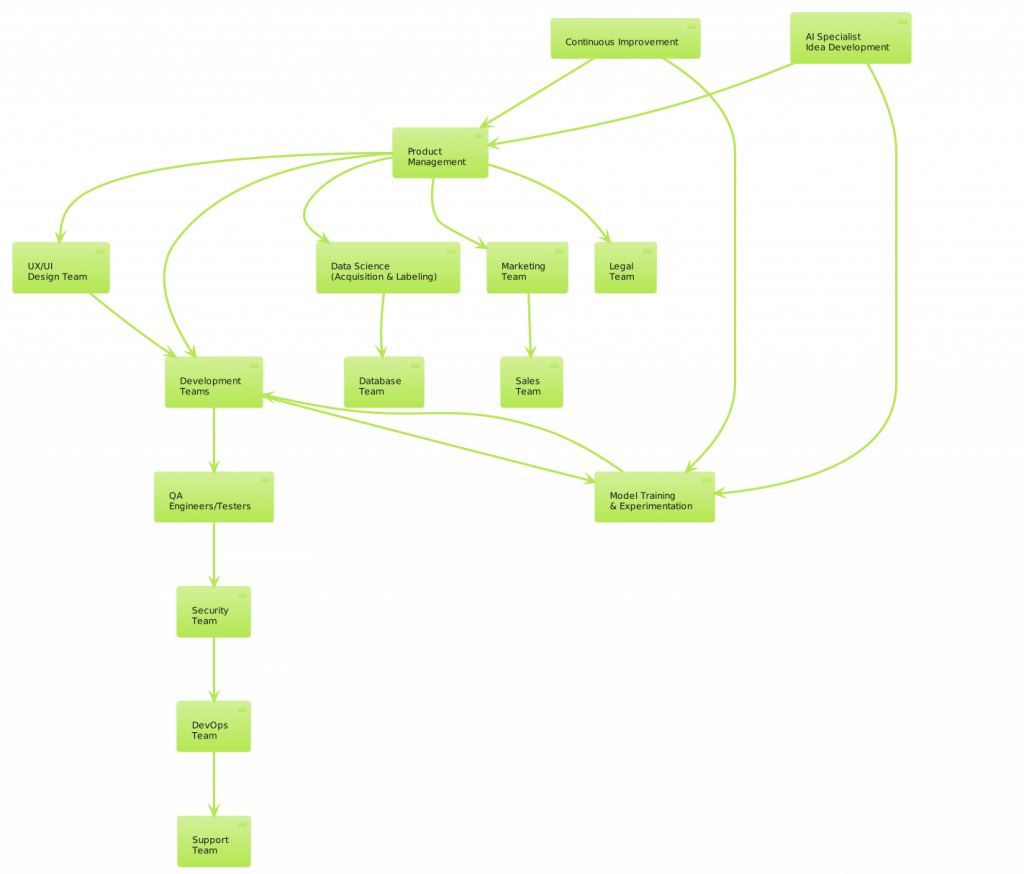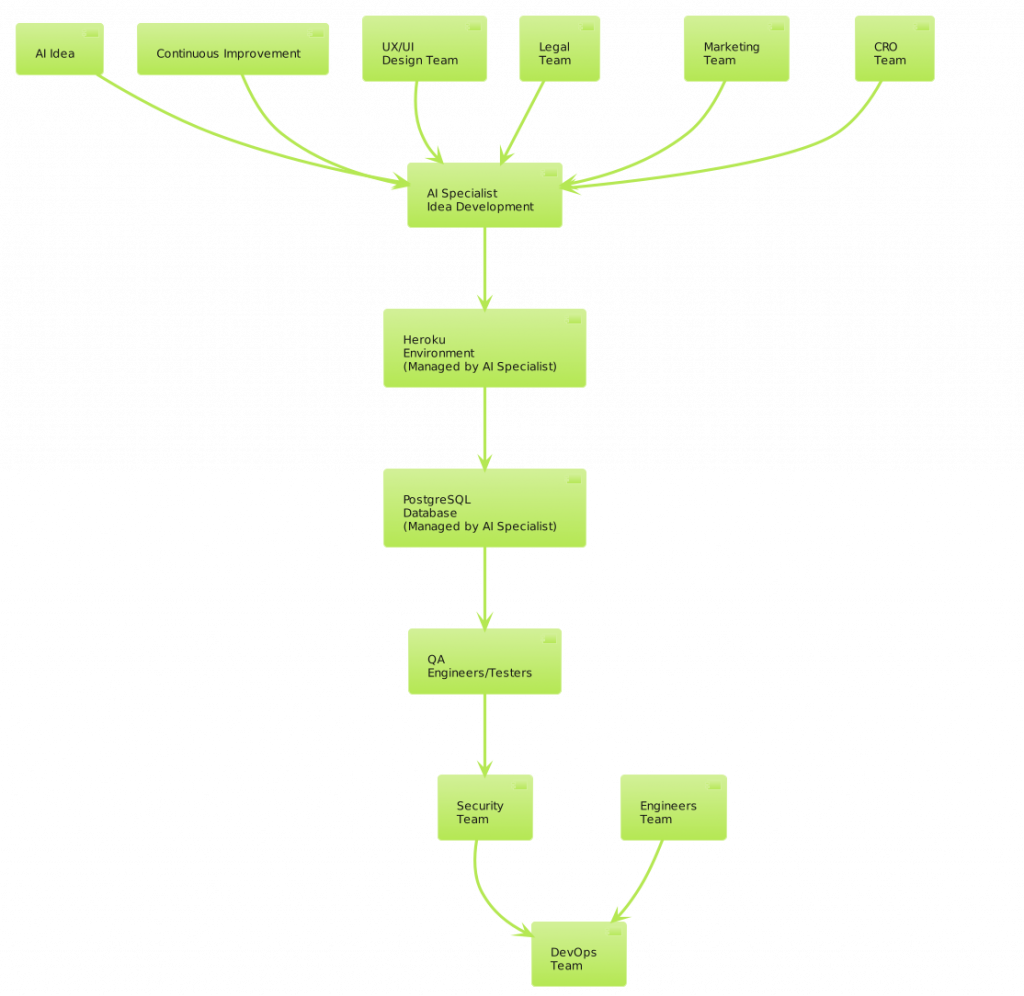
As an AI specialist working with a big company, you’re often the bridge between groundbreaking technology and real-world applications. The autonomy in this role isn’t just about comfort; it’s about necessity. Autonomy empowers you to apply your understanding of AI directly to the development process, circumventing the delays and dilutions that can occur when too many departments are involved.
The Collaborative Ecosystem: Navigating the Complex Web of Team Interdependencies in large IT companies.
AI development is inherently a process filled with experimentation, fine-tuning, continuous improvement, and discoveries. It’s a dynamic field where success often comes from the ability to adapt and innovate continuously. This process requires a deep dive into algorithms, relentless testing, and an openness to learning from failures to refine and enhance AI capabilities.
However, managing these needs within the ecosystem of large IT companies introduces its own set of challenges. The involvement of multiple teams, each with its own priorities and timelines, can complicate the streamlined process necessary for effective AI development. The iterative nature of AI projects, with their potential for initial failures and the need for constant adjustments, might not always align with the structured project management frameworks typical of large organisations. Additionally, coordinating tests across different segments of the company and ensuring that all stakeholders are aligned can be a cumbersome task, slowing down the pace of innovation and experimentation that is so crucial to AI development.
This environment makes it particularly challenging to maintain the agility and speed required for AI advancements, highlighting the complexities of integrating fast-paced AI development needs within the broader organisational processes of a large IT company.
Let’s have a look at this graph to understand these dynamics better:

The graph illustrates the intricate network of team interactions and the cycle of development for AI projects within a large IT company.
The visualisation captures several key aspects:
- Multiple Teams Involved: It clearly shows the involvement of various departments such as R&D, IT, data science, product management, and quality assurance. Each of these teams plays a critical role in the development process but also adds layers of complexity in terms of coordination and communication.
- Experimentation and Iteration: The graph depicts the iterative nature of AI development, marked by loops that signify the ongoing process of experimentation, testing, feedback, and refinement. This cycle is essential for the evolution of AI projects but can be challenging to manage across different teams with varying schedules and objectives.
- Potential for Delays and Setbacks: The interconnected paths between teams indicate potential points of delay and setbacks. For instance, waiting for data validation from one team or approval from another can significantly slow down the experimentation cycle, impacting the overall project timeline.
- Need for Continuous Improvement: The ongoing loops back to earlier stages of development highlight the necessity for continuous improvement and fine-tuning. AI projects are never truly ‘complete’; they require ongoing adjustments to adapt to new data, improve performance, and integrate user feedback.
Crafting the Autonomous Ecosystem: A Necessity for AI Specialists
The constraints highlighted by the complex scenario previously described, underscored the necessity for a shift to an ecosystem characterised by greater adaptability and independence.
Establishing an autonomous ecosystem for AI Specialists serves a dual purpose: it not only enhances the specialists’ ability to innovate, improve and execute projects efficiently but also delivers substantial advantages to the company. This approach accelerates the development process, reduces costs, and fosters a more agile environment where AI solutions can be rapidly adapted to meet evolving business needs. Having navigated the complexities and challenges of the scenario previously described, it became evident that a shift towards a more flexible and autonomous ecosystem was necessary. This realisation led to the adoption of a tailored suite of technologies: Heroku, Flask, PostgreSQL, and Tailwind.
- Heroku‘s cloud application platform offered the scalability and ease of deployment essential for agile development.
- Flask provided the lightweight framework needed for creating efficient Python web applications, enabling rapid development cycles.
- PostgreSQL was chosen for its robust data management capabilities, allowing for detailed tracking of AI responses and insights.
- Tailwind CSS enhanced the speed and flexibility of frontend development, facilitating quick iterations without compromising on design quality.

Have a look at the new scenario:
This streamlined ecosystem centers around the AI Specialist, enabling direct control over deployment on Heroku, management of a PostgreSQL database for data storage, and oversight of test data provision. This autonomous framework facilitates a smoother flow from idea development to deployment, with key processes and decisions managed by the AI Specialist. It illustrates a shift towards self-sufficiency, where the AI Specialist can operate with agility, free from the constraints of navigating a multi-layered corporate structure. By reducing dependencies on multiple teams and streamlining communication, the AI Specialist can execute rapid iterations and deployments, cutting down on the lengthy back-and-forths that often inflate project budgets. Additionally, this setup minimises overheads associated with coordinating numerous departments and harnesses technology to maintain lean operations, thereby maximising resource efficiency.
In Conclusion:
The transition towards a more autonomous ecosystem has been instrumental in streamlining AI development processes. Through this journey, I’ve learned the importance of autonomy in developing AI within a big corporate environment.
By shifting towards a self-directed approach, I’ve witnessed firsthand the benefits of increased agility, cost savings, and accelerated project timelines.


Leave a Reply